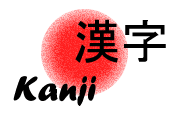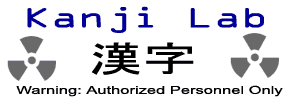
Departments

Full Color Online Japanese Kanji Cards (Basic Kanji)
hito 人 / ichi 一 / ni に / san 三 / shi 四 / go 五 / hi 日 / roku 六 / shichi 七 / hachi 八
More Kanji
For even more kanji info...
Why Learn Kanji? An Excerpt from
Why You Need a Foreign Language & How to Learn One: Second Edition, Revised and Expanded:
Buy it at Amazon.com / BN.com
Working with non-Roman Scripts
The language that you probably studied in high school—Spanish, French, or German—gave you a break that you perhaps never fully appreciated. These languages all employ the Latin, or Roman, alphabet. The same is true of all Western European languages, including Italian, Portuguese, Dutch, Swedish, and Norwegian.
Of course, we are not being completely honest here. Most Western European languages do contain a few letters that will be new to you. Spanish has the “n” with a tilde (ñ), as well as accented vowels (á,í,ó, etc.) German has the “u” with an umlaut (ü). Portuguese and French both contain the special “c” with a cedilla, which looks like a c with an upside down question mark attached (ç). But you can master all of these on the first day of class.
Consider the following: Even if you have never studied Italian, you could start reading a page of written Italian aloud, and others would understand at least part of what you were saying. You might not be completely comprehensible, and your accent would almost surely be atrocious. But at least some of what you read would convey a recognizable meaning to a speaker of Italian.
Now suppose that you pick up a page of written Arabic. All you would see is a mind-boggling swarm of squiggles. Your heartbeat would increase, and little beads of sweat would appear on your forehead. You wouldn’t have the first idea of how to pronounce anything. After a while, your listeners would shake their heads, grumble, and disperse as you looked helplessly at the sea of squiggles, reminiscing about how wonderfully easy Spanish class was.
The same would be true of Chinese, Thai, Farsi, Greek, Russian, Hebrew, Bulgarian, Japanese, Ukrainian, Burmese, Hindi, Urdu, Korean and Serbian. These languages all use non-Latin writing systems. Some of the languages on this list are harder than others. You could probably master Serbian or Russian in about half the time it would take you to learn Chinese or Arabic. Nonetheless, each of these languages requires you to do something that Spanish, Italian and German will never require: learn to use a new writing system.
Therefore, if you have chosen one of the above languages, you will have to make an early decision about how you are going to handle the writing system. Most textbooks of Chinese, Japanese, Arabic etc., employ a method called transliteration. Transliteration is basically a representation of another writing system using the Roman alphabet. For example, the Japanese word for “car” is kuruma. A Japanese would actually write it using a specific kanji, or Chinese-style character ( 車 ). However, if you pronounce, “kuruma,” your Japanese friends will know that you are talking about a car.
On your first exposure to the transliterated kuruma, you may experience what feels like an epiphany. You didn’t have to learn the Japanese character that represents kuruma ( 車 ) in order to communicate the idea of “car” verbally. So why not just skip the Japanese writing system altogether? Why not just learn Japanese using transliterations?
This is the temptation to which you must not succumb if you have chosen one of the non-Roman languages. There is nothing wrong with using transliterations in the beginning, while you are still learning the other writing system. However, as soon as possible, you should learn the other writing system and begin using it to learn the language.
The notion of a phonetically oriented alphabet is nearly universal. Therefore, once you master the system, you will have few problems using the foreign writing system as a medium for learning. In fact, your study of Russian, Bulgarian, or Serbian would actually be impeded if you relied on transliterations beyond the first week or two of your studies. The Cyrillic alphabet employed by these Slavic languages is easy enough for most students to master. Moreover, some of the transliterated Cyrillic sounds are awkward to work with. For example, there is a single Cyrillic letter that is transliterated as sh-sh. Rather than grappling with this unwieldy combination, it’s easier just to learn and use the corresponding Cyrillic letter (Щ).
The alphabets used in Korean and Thai are a bit more challenging; but once again, they are easier to work with over the long haul than transliterations. Even Japanese has a phonetically based alphabet. (Actually they have two, called hiragana and katakana. Although Japanese utilizes thousands of Chinese characters, most dictionaries contain a phonetic hiragana or katakana “spelling” of each word.)
The Middle Eastern languages, such as Arabic, are a bit trickier. These languages have alphabets, but short vowels are often omitted from texts written for adult readers. However, dictionaries and beginners’ texts indicate all the vowels. In time, you will be able to anticipate the short vowels in a word, much as an Arabic- or Hebrew-speaker does.
Chinese is the one language for which a prolonged reliance on transliteration is necessary. In order to master the Chinese language, you will have to master thousands of Chinese characters, each of which has a distinct pronunciation and tonal designation. Since Chinese has no real alphabet, a system of Romanized transliteration known as pinyin has been developed to help nonnative speakers learn the language. Although pinyin is no substitute for learning the characters, you will probably use it for supplemental purposes for an indefinite period. When you learn a new Chinese character, you will have no way of knowing its pronunciation without seeing the pinyin version.
Copyright © 2005 Beechmont Crest Publishing






